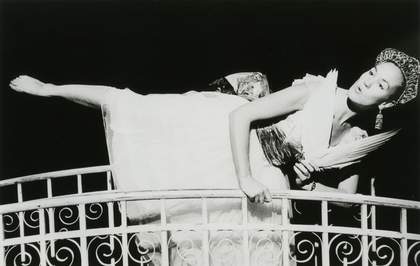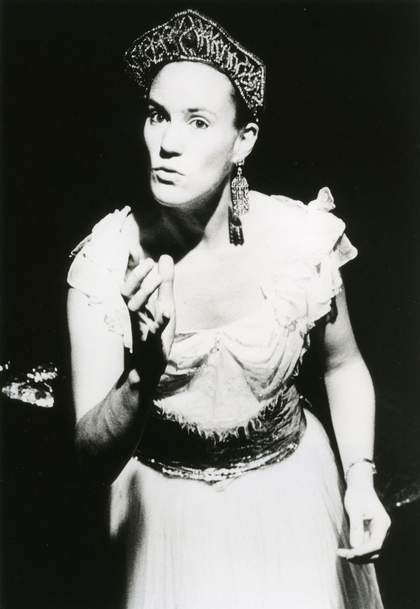The Beloved was a performance by Rose English that took place in Galleries 56ŌĆō9 at the Tate Gallery three times during 19ŌĆō21 September 1985. The performance was ninety minutes long and took place against an elaborate backdrop including two freestanding bridges made from timber and metal, a self-propelling electrical dodgem car with rubber wheels, a mechanism for a flying costume, a table and two chairs, and other miscellaneous props and objects. EnglishŌĆÖs performance interrogated the relationship between speech, performance and theatre, as she interacted with the audience and activated the objects in the overpopulated backdrop. The context of the gallery divorced the theatrical props from their function as mise-en-sc├©ne, while drawing parallels between the action of the theatre and the representation in the visual┬Āarts.
EnglishŌĆÖs performance was part of a group exhibition and performance programme titled Performance Art and Video Installation, which also featured Dora Birnbaum, Nan Hoover, Anthony Howell, Marie-Jo Lafontaine, Hannah OŌĆÖShea and Silvia C. Ziranek. The exhibition was described by Alan Bowness, Director of Tate Gallery from 1980 to 1988, as aimed at ŌĆśdemonstrat[ing] to our public the continuing relevance and interest of live artŌĆÖ.1 The choice of artists reflected diverse approaches to creating mixed-media, time-based work at that moment. English wrote and directed the performance, the producer was Luke Dixon and lighting was designed by Dennis Charles. English also hired an assistant called Alyson Silverman, who performed alongside her, in a minimal role. The Beloved was first performed at LondonŌĆÖs Drill Hall in February and later at the Bush Theatre, in the same year. It also toured to other galleries and theatres including Museum Moderner Kunst, Vienna in Kunst Mit Eigen Sinn; de Lantaren, Rotterdam in Perfo 3; Midland Group, Nottingham; and Theatre Workshop, Edinburgh┬ĀFestival.
English framed The Beloved around the conceit that she could not remember the true meaning of the word abstract. She said: ŌĆśIt is much more profound or complex than ŌĆ£non-figurativeŌĆØ or ŌĆ£non-representationalŌĆØ.ŌĆÖ2 This experience, as she explained to the audience, was the impetus for the performance: ŌĆśIt was the fact of forgetting it that sent QUIVERS OF PLEASURE coursing down my body as I lay there I said to myself, forgetting, forgetting the true meaning of the word ŌĆśABSTRACTŌĆÖ is a great, a GREAT SUBJECT, for a little hit show.ŌĆÖ3
EnglishŌĆÖs provocation highlights the artistŌĆÖs interest in complicating commonplace meanings and associations. This aspect of EnglishŌĆÖs performances was explored by Liz Rideal in her article in Performance Magazine, where she argued that the artist makes the audience ŌĆśwonder about the thorny problem of defining performance [ŌĆ”] as art? as theatre?ŌĆÖ4 English, she suggests, was undertaking a post-structuralist exercise, illustrating the fragility of terms used to describe differences between theatre and performance. As Rideal is forced to concede, ŌĆśbasically itŌĆÖs liveŌĆÖ.5
English began the performance by pretending to be asleep on stage. This quiet starting point dissolved the usual aim of a show to grab the audienceŌĆÖs attention.Furthermore, rather than use the performance to tell a story or let a narrative unfold, English punctured the fantasy of the performance space by addressing the audience directly and exploring the set, while remarking on the nature of having a set. The freestanding bridges, which critic Guy Brett described as ŌĆśthe epitome of a kitsch theatrical prop in splendid isolationŌĆÖ, provided a perversely ostentatious spot from which the artist declared her love for a dark corner of the stage.6 The transcript of the performance captures the┬Āmoment:
Some of you may not have noticed this little corner over here, because of course itŌĆÖs so much more eye-catching down that end of the stage. But thatŌĆÖs just a little theatrical device [gesturing emphatically at the bridge] ŌĆ” this little corner over here [becoming tender, whispering] itŌĆÖs completely won my heart ŌĆ” [speaking loudly], itŌĆÖs completely won my heart over, and therefore I will address it from the bridge [standing on bridge, addressing corner]. Small corner, shy one, shy one, shy one, corner, corner, do not disappear quite yet please, thank you my love, thank you dear one.7
Humour was a crucial element of the performance, extending from EnglishŌĆÖs speech, to her costumes and through her actions. Whether the action was exaggerated (for instance, consuming a large slice of chocolate cake while wearing a tutu), belated (waving a magic wand to announce a scene change that had already taken place) or ridiculous (driving onstage in a dodgem car), each undercut the seriousness of the performance space while creating an exciting and immersive experience. This was also achieved through EnglishŌĆÖs interaction with the audience, which included berating and interrogating them. While English might be said to have been challenging what it is to perform well, the performance was captivating and in fact tested the terms of this experience. An important part of this was the gender dynamics between performers, and between performers and the audience, as ideas concerning the power involved in looking and being seen, as well as active and passive roles, were circulating in feminist-influenced theory at the┬Ātime.
English took an active position in the performance, while the second performer, Silverman ŌĆō who played the role of an assistant ŌĆō had no lines and only carried the props at EnglishŌĆÖs command. Although this seems to create an unequal power relationship between the two, Brett has suggested that the presence of the second performer creates a different dynamic with the audience. He argued that if the assistant becomes the witness, the audience are forced into a more productive dialogue and therefore they become both more immersed in and actively responsive to the performance.8 In an unpublished interviewed with Michael Archer, English expanded on this idea, describing the relationship between herself and the┬Āaudience:
I think thereŌĆÖs an agreement to witness, predominantly, but also to participate in something that is going on [ŌĆ”] I think thereŌĆÖs a degree of consent, in terms of us both, to pursue a certain direction and a certain line of investigation, which would not be possible without those witnesses being present. I donŌĆÖt see any function in stopping somebody from thinking. If you make them feel uncomfortable then they stop thinking.9
EnglishŌĆÖs use of comedy in The Beloved allowed the artist to connect with her audience, to elicit their responses and share experiences, rendering the performance space a more communal site. In this way English occupied a theatrical scene, inviting the audience there with her to remark on the constructed division between the performer and the audience as well as the fragility of what can be considered ŌĆśrealŌĆÖ.
Philomena Epps
┤Ī▒Ķ░∙Š▒▒¶╠²2016



